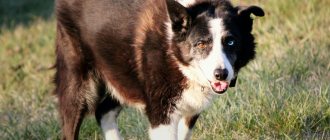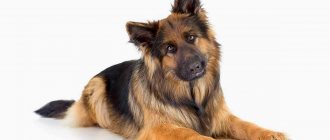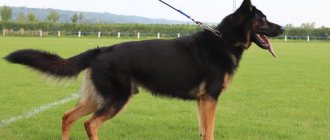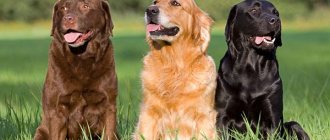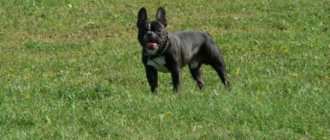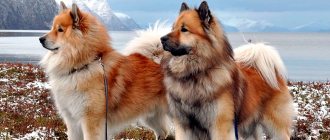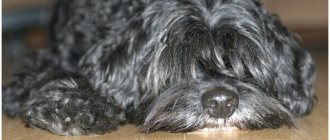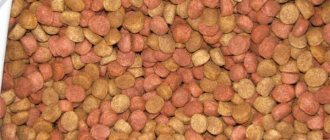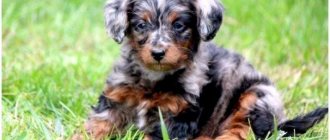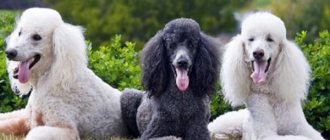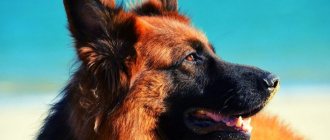90% of service dogs are representatives of the German Shepherd breed.
The founder of this breed, Max von Stefanitz, had the goal of breeding socially useful dogs with outstanding characteristics and good obedience.
They must be brave, tolerant of other animals, protect entrusted people and the herd, and carry out assigned tasks.
The result is excellent - the dogs are hardy, trainable, smart, and good friends. They are excellent guards and detectives.
In this article we will look at the types of German Shepherds - here you will find their descriptions with names and photographs.
Main varieties
There are two main varieties of German Shepherds:
- exhibition;
- workers.
The first demonstrate breed standards in terms of appearance, taking part in various exhibitions and undergoing testing for training. They also have working qualities, thanks to their gentle nature they serve as guides and guards, and provide canis therapy.
The latter do not have high standards of appearance , but well-developed muscles, strong bones and a strong, fearless character make it possible to regularly perform grueling service.
Dogs of both species participate in exhibitions, show working abilities, but the quality of the intended purpose of the species is always a priority.
Expert opinion
Kozhevin Semyon Kirillovich
Expert dog handler.
When a German Shepherd is supposed to come to me, I wait with excitement: “Which dog will come to me?”
A lot of people started breeding dogs of this breed, and due to ignorance in this matter, a whole population of spoiled dogs appeared.
According to my observations, there are three types of this breed:
- exterior;
- workers;
- from breeders (incompetent breeders hungry for quick money).
The first ones participate and win in exhibitions and rings, and pass training tests. They have a balanced nervous system, many are well guarded. The weak point is the joints; dogs often fall on their hind legs. Almost all representatives have some kind of disease, often related to the digestive system, and many have allergies.
The latter are not very similar to their elegant exterior counterparts. Structural features - no extra-long paws, more compact, less angular, similar to the old-type Germans. Confident in yourself. They are characterized by endurance - the main characteristic of the German Shepherd. It is the workers who preserve the character of the breed.
Still others look like German Shepherds. They are unfit for work, nervous, excitable and cowardly. The legs are very long, the narrowed muzzle is elongated, the chest is small in volume, and the bones are poor. The behavior of the future dog will be revealed by the habits of the parents, who should be observed so as not to fail when choosing a puppy.
Character
The German has a balanced type of nervous system. The pet remains calm and reasonable in any situation. Shepherd breeds are not inclined to show aggression simply; they attack quickly and swiftly, only in those cases that really require physical impact.
The dog is hardy, has acute hearing and developed sense of smell. Shows enviable courage and will rush to defend its owner, regardless of the size and power of the enemy. Germans are distinguished by excessive vigilance and distrust of strangers, which is the only drawback of the breed (and quite subjective). In the first years of life, the shepherd is characterized by increased playfulness and activity. By a more conscious age, the dog calms down and begins to obey its owner unquestioningly.
Classification by coat length
Based on the length of their coat, German Shepherds are classified as smooth-haired ( short-haired ) or long-haired .
Smooth-haired cats have a double body covering - hair with a thick undercoat. The first should fit snugly to the body, be straight and rigid. The hair is longer on the neck, back of the paws and tail, shorter and thicker at the base of the ears, front of the paws, and toes. On the back of the thigh are pants.
In any litter there will be a puppy that differs from its brothers in the length of its fur. Long-haired individuals have longer hair, the undercoat is slightly marked. At the base of the ears, the hair is collected in bristling tufts, and on the tail it is 2-4 times longer than that of shorthairs.
Characteristics of the German Shepherd breed
- Country of origin of the breed: Germany;
- Color: black and tan, black and silver, black and red, black, gray, sable;
- Male weight: from 30 to 40 kg; female weight: from 22 to 32 kg;
- Male height: from 60 to 65 cm. Female height: from 55 to 60 cm;
- Life expectancy: from 9 to 13 years.
Photo: German Shepherd
Photos and descriptions of species
Based on their uniqueness, character traits , and distinctive external features, breeding lines of the breed are divided into three types:
- German exhibition;
- European workers (subspecies - Western, Czech, East German, Dutch, Belgian);
- American exhibition.
Old type
The German Shepherd of the old type of breeding differed from its contemporaries in its tall, dry, sinewy body with strong bones, which corresponded to the standards of the forties and fifties of the twentieth century.
The old-type American line (bred before the seventies of the twentieth century), which did not show outstanding results, has almost disappeared. The reason for this is the development of a new American breeding line.
Workers
The East German line was created from the remaining dogs in East Germany after World War II. Dogs of this line have a variety of working qualities and good build, having heavy bones and a large head. Some are aggressive. Hardy, capable of learning.
Partners for breeding working lines are selected based on high estimates of suitability for the breed. The goal of breeding is to create a dog that exceeds all previous characteristics of the breed. For this purpose, it is not so much the beautiful who are selected as the brave, quick-witted, willing and able to carry out assigned tasks, with a balanced psyche and flexible character.
Dogs must not only work, but also produce good offspring. Priority is given to health - if the animal is of good character, but with diseases, it will not be able to serve. Therefore, working line dogs are powerful, fast and agile, and very hardy.
The appearance is not much different from the exterior of the ancestors. Working shepherds come in different sizes - either squat, short-bodied and dense, or tall and thin, with short or long hair. Any color, black saddle is more common.
Used as utility vehicles, they are successful in police and search and rescue work. Ideal for work in the ring, sports, competitive level (for example, agility) competitions, personal protection.
American
In the category of American exhibition lines I also include Canadian ones. The goal is to breed dogs for the show ring, where conformation, movement, and appearance are assessed.
This species is now fundamentally different from the original German Shepherds imported to North America and from the European Shepherds. This happened due to differences in standard requirements in Europe and America.
NOTE!
The American Kennel Club has no requirements for both parents; registration as purebred shepherd dogs is sufficient. Even puppies that do not pass health, temperament and performance tests can participate in the production of offspring.
American Shepherds differ from German Shepherds in the height at the withers and the length of the body. They have thinner bones, the body and head are narrower. The color is traditional saddleback, there are black and white individuals.
English
The line was bred from old-type German Shepherds that were imported to the British Isles. They were used as police officers and guides due to their gentle nature.
Since England did not prohibit the import of German Shepherds after the war, they supplanted the English breeding line.
German (high breeding)
Representatives of this line are popular in Germany as they are closest to the standards. Distributed all over the world due to its exhibition exterior. Easy to get divorced. The color is predominantly black and red, the step is smooth.
Flaws:
- weak character;
- fading pigmentation.
IMPORTANT!
In Germany, parents of puppies registered as German Shepherds must have conformation assessments, training results and medical testing, which provides some guarantee of the health of the breeding stock.
Thanks to this, dogs of show lines retain working qualities that allow them to serve and participate in competitions. But the main focus of breeders is on improving appearance. Therefore, a dog that is not distinguished by good health and strong character, but with an excellent exterior, will be selected as a mating partner.
Czech
This line was developed during communist Czechoslovakia. The goals and culture of the then Eastern Europe determined the breeding of Czech Shepherds.
These dogs are suspicious and aggressive. Very similar to German working dogs in appearance, character and ability to serve. Significantly different from German and American show dogs.
Swiss
The German Shepherd of the Swiss breeding line has a white color .
White color (dominant hidden gene) is considered a defect in many countries and is disqualified.
NOTE!
The International Canine Organization (FCI), after attempts by breeders to achieve recognition of the white line, separated it into a separate breed - Swiss Shepherds. In North America they are recognized as Canadian or American White Shepherds.
These are dogs of good build, with a gentle character and variable temperament. They serve as guides.
White color helps in performance of duty and is in no way a sign of degeneration or albinism. Representatives of the Swiss line must have dark skin, irises, black pads and claws.
Kunming
In the fifties of the twentieth century, the Chinese province of Yannan with its capital Kuming needed military service. For this purpose, the Kunming line was bred on the model of the German shepherd (the likelihood of outbred producers is high). Ten Peking Wolfhounds, twenty local dogs and ten German Shepherds were crossed.
The result was medium-sized dogs with square body proportions and longer legs, resulting in a loss of elegant gait. The color is typical for Germans, variegated is allowed.
The psyche is stable, animals are capable of learning, and are excellent companions. They serve as military, police, and detectives.
Sarlouz Wulfhound
When crossing a European wolf with a German shepherd to improve the qualities of the breed, a genus was developed that was registered by the FCI system as Dutch.
An exhibition breed, the animals have a stable psyche and an aggressive character. Fearless, determined. The color is white or wolf. Wolfish habits progress and commands are difficult to carry out.
Briefly about the main thing
- The German Shepherd is a breed of dog that is often used for service, to guard the herd, or as a pet.
- The main varieties of colors according to the standard are zoned, saddleback and black. Combinations of these colors are possible.
- All other shades of German wool are defects of the breed. Such dogs are bred only in the pet class. The most beautiful colors are roan, gray, white, golden and spotted.
Will atypical shepherd colors be included in the breed standard? Share in the comments which coat color suits Germans best.
Popular colors
In accordance with the standards, the colors of German Shepherds are as follows:
- zonal (zonal-red, zonal-gray);
- black-and-white;
- plain gray;
- black plain;
- black and tan;
- black with a hint of brown, the so-called “dark sable”.
Due to its effectiveness, the most common color is sable. Breeders are working to restore the rest to their former glory.
IMPORTANT!
The basis for disqualification is weak pigmentation, indicating the inferiority of the individual, the presence of a disease - vulnerability of the skin to ultraviolet radiation. The reason for this is intraspecific crossing. The weakness of the pigment is manifested in the light color of the iris, white chest and paws, in light claws and the tip of the tail.
Deviations from the color standard
All other colors are considered a defect of the breed. Such pets are not allowed for exhibitions and are not suitable for breeding. However, unusually colored pets are expensive and are valued among owners for their uniqueness, since deviations from exterior characteristics are rare among “Germans”.
Red (yellow)
Red (yellow) color
The coat is colored red. This variation should not be confused with the zonal red, which is the standard. Rejected dogs come in many shade combinations from fiery to light yellow. There is no saddle cloth or mask on the face.
Grey
Gray color
The color appears as a result of a mutation that weakens the influence of gene A. It is called asphalt, “silver”, blue. Characterized by significant lightening of the fur on the belly, paws, and chest. Sometimes their irises brighten.
Gray-blue individuals look attractive, but are not involved in mating. However, American breeders are trying to breed asphalt “Germans” with amber irises.
Golden
Golden color
A variety of yellow color. The difference is that the fur is even lighter, and a separate bright pigment is responsible for this. On the belly and inner thighs the coat is almost white, with a beige or dirty yellow undertone.
In the sun the hair shines gold. Dark tones predominate on the face, and a barely visible mask is characteristic.
Spotted
Spotted color
The base is white, with spots of brown and reddish color scattered on it in a chaotic manner. The spots do not have clear shapes and can be either very large or small.
Spotting is not caused by mutation, but by crossing with outbred dogs or with Australian Aussies, which are characterized by the presence of a variety of spots.
Roan
Roan Coat Color
Roan coat color is not a separate species. Age-related changes affect the pigment of the hair, it gradually disintegrates, and the hair turns grey.
When gray hair spreads over a larger area than the main color range, the color is called roan. This process occurs most often in older pets.
White
White color
White color appears when two recessive genes coincide in a dog, which happens very rarely. Light colored individuals are highly valued, although they are rejected by the breed standard. It is believed that they are very flexible, more family-oriented and gentle.
White “Germans” are not albinos; the albinism gene is not characteristic of them. Albinism is a disease in which the formation of the melanin pigment is impaired. It is responsible for the coloring of hair, irises, and claws.
Albinos have blue or pink eyes and a pinkish nose. With white coloring, the pigmentation of the nose and eyes is preserved. Animals of this color do not have concomitant diseases characteristic of albinos: hearing impairment, vision impairment, photophobia.
We recommend reading:
- How many years do German Shepherds live, life expectancy in different conditions and how it can be influenced.
- Rating of dogs by intelligence, find a German Shepherd there and you will be very surprised.
Rules of care
Caring for zoned Germans is usually not difficult for owners. These are quite unpretentious animals in terms of keeping conditions. During the shedding period, the shepherd dog must be brushed every day; in normal times, it is enough to carry out this procedure 3-4 times a week. For combing, you can use a furminator or a special mitten.
The pet's eyes, ears and mouth must be inspected every day for dirt and possible inflammation. Cleaning is done as needed. The procedure for trimming nails for this breed is usually irrelevant; walks are enough, during which they grind down on hard surfaces on their own. However, if necessary, you can use a regular nail clipper.
Origin
In the 18th century, Spanish shepherds were accompanied by stocky dogs. Very ugly in appearance, they desperately defended the flocks from offenders.
Catalan Shepherds are confused with Pyrenees Shepherds. Both breeds are similar in appearance. This is the first and last point of generality. It became the basis for the emergence of one of the versions of the origin of the Catalan dog breed. It says that in the 17th and 18th centuries, French cattle drivers led flocks through Spain. They were accompanied by dogs. Short, quite aggressive, with long hair, they zealously carried out their work.
Local shepherds liked the four-legged guards. And they begged the drivers for a couple of dogs. This story is bursting at the seams, because who in their right mind would give away an excellent dog.
Brown Catalan Shepherd
The second version of the origin of these animals tells that the breed was formed in the West of Spain. Without the help of breeders, strong individuals survived, weak ones died. The Catalan Cattle Dog has remained virtually unchanged in type since that time. A natural question arises: how is the western part of the country connected with Catalonia, located in the Northeast.
The third version is the most truthful. The long-haired shepherd dog was bred in the Catalan mountains. Unpretentious, smart and energetic, this is exactly the kind of four-legged companion that local shepherds needed. Over time, the exterior of the animals has undergone only minor changes. Working qualities are fully preserved.
Nutrition
Like any dog, the Shilon Shepherd needs to be fed quality foods at least twice a day . Lean chicken or turkey meat, meat broth, grated vegetables in combination with cereal porridges, and low-fat dairy products are suitable as a natural diet. You can give your dog beef or pork bones from time to time.
When chewing such a bone, the dog sharpens its teeth. Dry food is also suitable for daily use. Mixing natural food with dry food is not recommended, as this can upset the dog’s stomach.
Grey
Greek and Central Asian, South Russian Shepherd Dogs, Briard - these are the breeds that can have a gray color.
An interesting breed is the Puli, which comes in white, gray, and other colors.
Puli dog
The fur is formed into cords that completely hide her brown eyes. Puli is a very smart and loyal, but also a serious dog.
If she thinks her owner is in danger, she will attack without warning.
The Catalan Shepherd is found in both gray and other colors.
Catalan Shepherd
Her coat is hard, with a thick undercoat, the dog is decorated with a lush collar, mustache, beard, and bangs. The wool is long.
The dog's appearance is very funny, and his character is energetic and cheerful.
The Romanian Mioritic Shepherd is massive, covered with thick white or fine hair, sometimes with different spots. She is surprisingly obedient and extremely affectionate.
Romanian Mioritic Shepherd Dog
Only the owner himself can train her: she “falls in love” with only one person, once and for all. The Romanian Shepherd will never betray its owner, even if he is no longer there.
